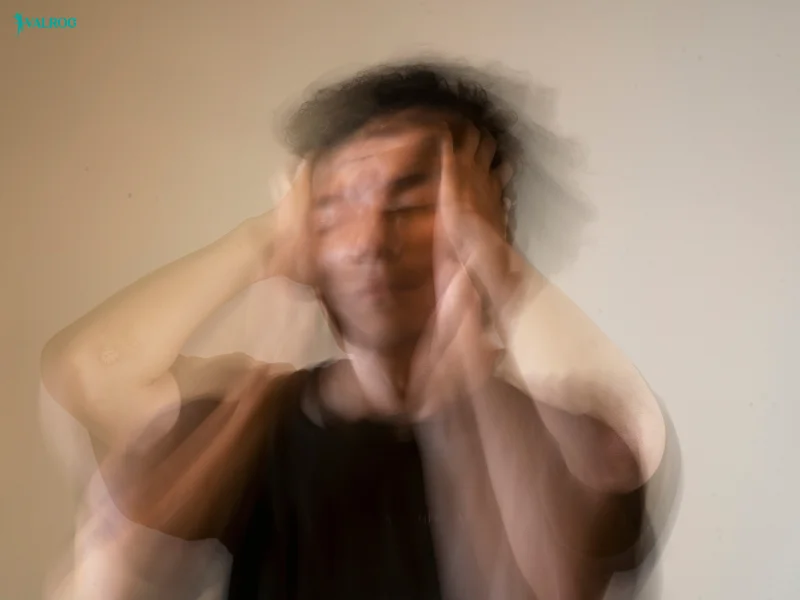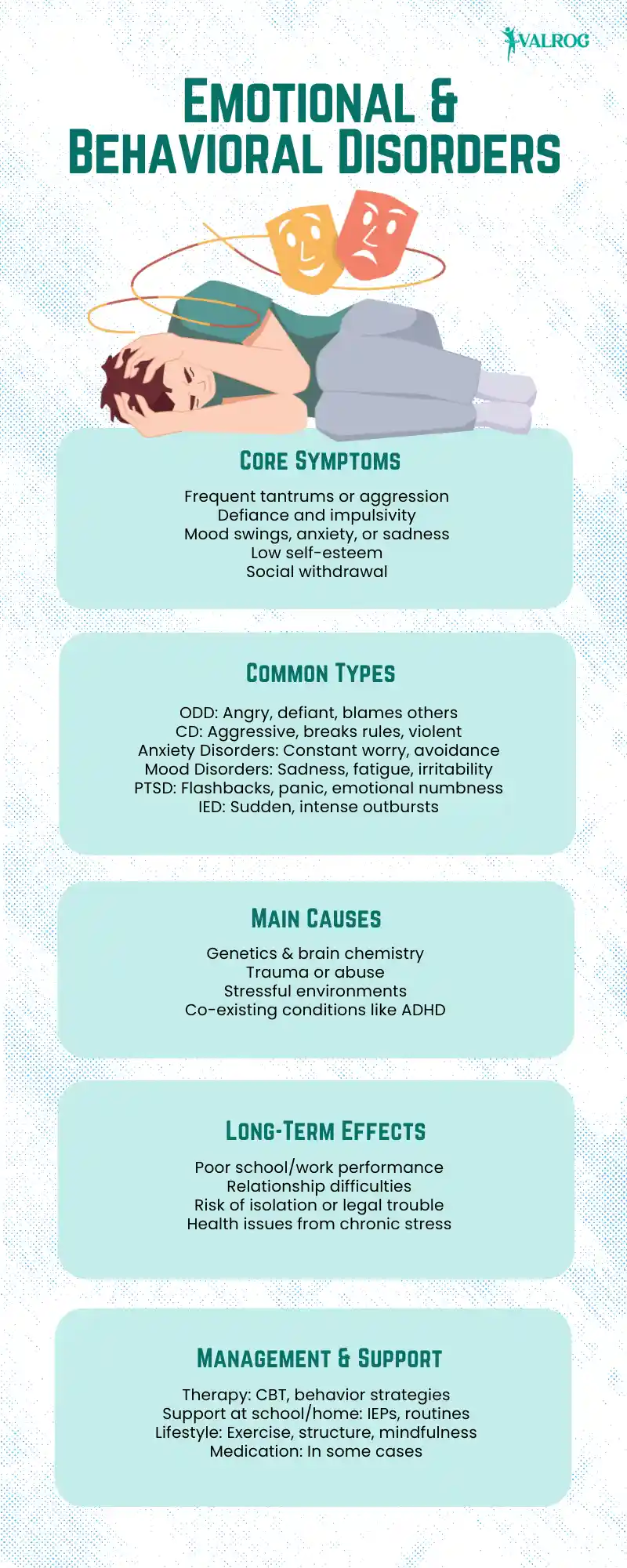“Children aren’t born with behavioral problems. They’re shaped by environments they cannot control.” – Dr. Ross Greene
Have you ever witnessed a child or an adult explode over what appears to be nothing? Or have poor concentration, link, or deal with frustration? It may not be the bad attitude; it may be an emotional and behavioral disorder (EBD).
It is not only the scholars or educators who need to understand the emotional and behavioral disorders. These disorders impact life, relationships, occupations, and views to some extent. What are these ebds? What do they look like under the surface of names such as emotional and behavioral disorders? Let us find out what these ebd disorders are about and their causes, symptoms, and effects.
What are Emotional and Behavioral Disorders?
Let us first clear the air of one fundamental question: What is EBD (emotional and behavioral disorder)?
An emotional and behavioral disorder (EBD) refers to a mental diagnosis in which an individual demonstrates a majority of disruptive emotional and behavioral tendencies. These do not just constitute normal mood swings or acting up but affect daily functioning, learning, and relationships.
Emotional behavioral disorder in the Individuals with Disabilities Education Act (IDEA) implies cases when the individual:
- Problems in trying to preserve circumstances in interpersonal relations
- Acts wrongly in normal circumstances
- Experiences depressive or unhappy moods to a pervasive degree
- Enhances phobias revolving around school or personally stressful issues
In simplified terms, the emotional behavioral disorder definition revolves around persistent emotional imbalances and behavioral problems that are not age-appropriate.

EBD Meaning in Real Life
In this section, we’ll define the core aspects of emotional and behavioral disorders definition in everyday life.
EBD Meaning and How It Shows Up
The EBD meaning goes beyond classroom disruption. It includes:
- Emotional dysregulation – frequent anger, anxiety, sadness
- Aggressive or withdrawn behaviors
- Chronic defiance or impulsivity
- Social difficulties or isolation
For example, a teenager with EBD might experience emotional outbursts when asked to complete a task. Or an adult may avoid social interactions entirely due to intense anxiety or paranoia.
Define Emotional Behavioral Disorder Clinically
Emotional behavioral disorder is defined by psychologists according to DSM-5 (Diagnostic and Statistical Manual of Mental Disorders), the criteria of which include such disorders related to it as:
- Oppositional Defiant Disorder (ODD)
- Conduct Disorder (CD)
- Anxiety Disorders
- Mood Disorders
- PTSD

Symptoms of Emotional and Behavioral Disorders
Here we break down common symptoms and how they differ across age groups and types of EBD.
Behavioral Symptoms
- Frequent temper tantrums or physical aggression
- Refusal to comply with rules or authority figures
- Destructive behaviors (toward self or property)
- Excessive talking, fidgeting, or restlessness
Emotional Symptoms
- Constant feelings of sadness or hopelessness
- Unpredictable mood swings
- Intense fears or irrational worries
- Poor self-esteem or self-hatred
Symptoms in Adults
While behavioral issues in adults may look different from those in children, they often include:
- Risk-taking or impulsivity
- Chronic anger or irritability
- Substance use as emotional regulation
- Difficulty sustaining work or relationships

Types of Emotional and Behavioral Disorders
This section will talk about general forms of emotional/behavioral disorders, the difference between them, and what indications to look out when it comes to each one.
1. Oppositional Defiant disorder (ODD)
ODD is characterized by unremitting disobedience, anger, and quarrelling. The children with ODD usually dislike obeying rules, intentionally irritate others or accuse other people of their errors.
- Symptoms: wrath, vindictive attitude, vengeance orientation
- Most common in: 6- to 12-year-old children
- Tends to co-occur with: ADHD or learning disorders
2. Conduct Disorder (CD)
This condition entails worse behavioral problems like acting violently, destruction of property, and disobeying social norms.
- Symptoms: Physical combats, cruelty to animals, theft, truancy
- Most common in: the adolescents
May cause an antisocial personality in the adult stage when untreated
3. Anxiety Disorders
Anxiety disorders are emotional imbalances and lead to extreme fear or concern. They may interfere with attention, sleep and social life.
- Examples: Generalized Anxiety Disorder, Social Anxiety, Panic Disorder
- Symptoms: Worrying constantly, panic attacks and avoidance
4. Mood Disorders and Depression
Mood disorders such as bipolar disorder and major depression disorder influence energy levels, emotion regulation and behaviour.
- Symptoms: sadness, tiredness, angry, suicidal thoughts
- May be either anger or withdrawal among children and teens
5. Post-Traumatic Stress Disorder (PTSD)
PTSD is a post traumatic situation. It falls into the category of emotional disorders and is followed by hypervigilance, nightmares, emotional numbing.
- Common in: Authorities of abuse, former military, victims of accident
- Triggers: Sound, recollection and locations linked to trauma
6. ALD, intermittent explosive disorder (IED)
IED means outburst of subjective moments of impulsive aggression. They have frequent outbursts which are usually disproportionate to the situation.
- Symptoms: Tears, hitting, road rage
- Typical of: Adults and older teens
All these and other forms of emotional and behavioral disorders vary in symptoms and severity but whenever unmanaged, they have serious consequences that affect the quality of life. Identifying the appropriate type will be a first step towards giving specific and quality support.

Causes of Emotional Behavioral Disorders
We’ll explore biological, environmental, and psychological contributors to EBD.
Biological Causes
Others are born with emotional disorders. There are contributing factors, which include:
- Mental illness in the family
- Abnormalities in Brain chemistry or structure
- Exposure of the unborn fetus to toxins or stress
Environmental Triggers
Emotional health can be grown and upset by our environment. The usual causes are:
- Abuse of neglect
- Violence exposure
- Irregular or strict parenting
- Trauma or bullying at school
According to a study in the National Institutes of Health (NIH), developed in 2018, the prevalence of adverse childhood experiences (ACEs) has a potent connection with behavioral disorders in the future.
Psychological Risk Factors
EBD may be accompanied by such conditions as ADHD or autism spectrum disorder, making emotional control more difficult.
Effects of Emotional and Behavioral Disorders
In this section, we’ll talk about the effects of EBD on education, social life, profession, and health will be marked.
Academic and Professional Reflections
Special needs children have issues with achieving academic standards. Actually, they graduate from high school in only 54 percent, which compares to 84 percent of their peers. This may result in:
- More school expulsions or suspensions
- Inadequate employment or the frequent loss of a job
- Problem staying in line with workplace regulations
Social and Emotional Effects
It is possible that people with EBD might experience difficulty:
- Make or keep friends
- Manage disagreement without confrontation
- Fortify against criticism or rejection
Without quick treatment, these behaviors can lead to loneliness, depression, and in serious cases, even jail.
The Implications of Physical Health
Emotional dysregulation stress may lead to:
- Sleep disturbances
- Gastrointestinal issues
- Blood pressure/risks to the heart
Strategies of Treatment and Support
We will present a description of the professional and home-based interventions in the management of EBD symptoms.
Professional Interventions
- Cognitive Behavioral Therapy (CBT): Aids in making people understand and change negative thinking.
- Behavioral Therapy: Adopts reinforcement mechanisms in encouraging positive behaviors.
- Medication: Depending on symptoms, medication may be antidepressants, mood stabilizing drugs, or stimulants.
School-Based Supports
- Individualized Education Plans (IEPs)
- Positive Behavioral Interventions and Supports (PBIS)
- Good practice in social-emotional learning (SEL programs)
Home and Lifestyle Tools
Parents and caregivers can:
- Set clear expectations and routines
- Model healthy emotional expression
- Encourage physical activity and mindfulness
Online communities and local support groups like those listed on MentalHealth.gov offer ongoing resources.
Emotional Behavioral Disorder in Adults: Underrecognized and Untreated
Though often identified in childhood, EBD doesn’t disappear with age. Many adults go undiagnosed, labeled instead as “difficult,” “unmotivated,” or “lazy.”
If you or someone you love:
- Struggles to hold a job
- Frequently lashes out or isolates
- Feels out of control emotionally
It may be time to explore an emotional and behavioral disorders diagnosis. Early recognition leads to better outcomes—at any age.
Conclusion
Emotional and behavioral disorders are not mere mood disorders as well. They constitute critical issues which can interfere with the everyday life, relationship and future prosperity. Moreover, it is possible to detect the symptoms in time among both children and adults. Through treatment, encouragement, and frequent attention, individuals are capable of controlling the disorder borders to make their lives better.
Through the understanding the definition of emotional behavioral disorder and the underlying causes, this stigma can be broken. Because of it effective treatment can be administered. When ever you think of or experience an individual experiencing recurrent emotional or behavior problems do not dismiss these signs. Nothing can be sweeter than early intervention. The preliminary step towards permanent change and recovery is learning about emotional or behavioral disorders.
